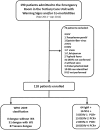Clinical relevance of gallbladder wall thickening for dengue severity: A cross-sectional study
- PMID: 31469845
- PMCID: PMC6716627
- DOI: 10.1371/journal.pone.0218939
Clinical relevance of gallbladder wall thickening for dengue severity: A cross-sectional study
Abstract
Dengue fever is the most important arthropod-borne viral infection worldwide. Secondary prevention to reduce mortality through improved clinical case management has substantially lowered the mortality rate for severe dengue during the past two decades. Gallbladder wall thickening (GBWT) is a nonspecific finding often associated with more severe cases of dengue infection. This study had the aim to describe the ultrasonographic findings in hospitalized patients with dengue infection from Manaus (in the Western Brazilian Amazon) and to correlate the GBWT with dengue severity, symptoms and laboratorial analysis. Patients from 13-84 years admitted to the emergency department at the Fundação de Medicina Tropical Dr. Heitor Vieira Dourado (FMT-HVD) were enrolled in this study. Patients' selection occurred during the most recent and huge dengue outbreak within the first semester of 2011. All enrolled subjects were systematically tested in order to rule out other possible etiologies for gallbladder inflammation. Abdominal ultrasound was performed by a single physician through bedside portable equipment and all other clinical and laboratorial information were retrieved from patients' electronic files. 54 subjects were considered for analysis, with confirmed dengue infection by NS1 and/or RT-PCR positivity. From all enrolled patients, 50 (42.4%) presented GBWT. GBWT was significantly and independently related to: age under 31 years, pregnancy, presence of bleeding, presence of any cavitary effusion, DHF classification and severe dengue classifications. During dengue outbreaks, the GBWT identification through a non-invasive and bedside procedure is a confident marker for prompt recognition of potential severe cases.
Conflict of interest statement
The authors have declared that no competing interests exist.
Figures
References
-
- World Health Organization. Guidelines.
-
- Simmons CP. Dengue.
MeSH terms
LinkOut - more resources
Full Text Sources
Miscellaneous




